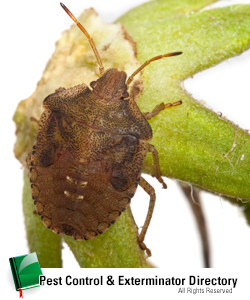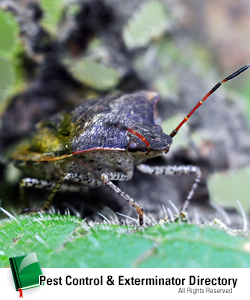All about Stinkbugs
 Stinkbugs are shield-shaped bugs, which have five segmented antennae and a triangular scutellum. They produce unpleasant odor, if anyone crushes them. They are ¾ inches long and are brown, gray or dark green in color. They belong to Pentatomidae family.
Stinkbugs are shield-shaped bugs, which have five segmented antennae and a triangular scutellum. They produce unpleasant odor, if anyone crushes them. They are ¾ inches long and are brown, gray or dark green in color. They belong to Pentatomidae family.
Stinkbugs feed on leaves, flowers, fruits and crops. They also eat other pests, particularly caterpillars. They live in gardens, farms and orchards. Though they are harmless to humans, but can cause a lot of damage to plants and crops.
The adult green Stinkbugs have orange-yellow line bordering the major body regions. Adult brown stinkbugs have dark punctures on their back. The adult female stinkbugs lay eggs on the underside of leaves in clusters. They require suitable hosts to deposit their eggs. After hatching, the eggs emerge into the nymph stage. They develop and begin to feed on plants. The stinkbugs require a supply of bacteria, which they store in their intestinal pouches. The nymphs require supply of bacteria, which is deposited by the female stinkbugs at the time of laying eggs.
The stinkbugs have needlelike mouthparts, which are used to suck sap from pods and buds. They feed on developing hosts of several hosts, including trees, shrubs, weeds, cultivated crops and vines. They feed on peaches and other fruits on the growing seasons, causing a gnarling and distortion of that fruit, which is commonly referred to as cat facing.
There are three types of stinkbugs that affect soybean and cotton- brown stinkbug, green stinkbug and southern green stinkbug. The brown stinkbug is the most difficult pest to control.
Stinkbugs are active insects found all over the United States. Though they are prevalent in gardens, they can find their way to homes and structures, especially if the climate is not favorable for them. The pungent smell released by stinkbugs while crashing is due to cyanide compounds in their body. They have thick wing covers like shield and so they are also known as shield bugs. They are agricultural pests that cause damage to plants and crops.
Stinkbug species include green shield bug, horehound bug, brown marmorated stinkbug and forest bug. Green shield bug does not have any markings in their body. They are prevalent in Britain. They prefer to live in gardens. Horehound bug is a type of stinkbug, which sucks the sap of horehound plants. They go through five nymphal stages during their lifecycle. They have orange body with black markings. Though they have an appetite for horehound plants, they also feed on other trees and shrubs.
Brown Marmorated stinkbugs originated in Asia, but they are now found in the United States also. They are 5/8 inch long and have grey or black markings on their body. Their stink glands are located on the underside of the thorax. They have brown legs with faint white banding. They can cause heavy damage to the vegetable and fruit crops. They even enter into homes during colder climates. They leave a powerful scent on everything they land on. They use their odor as a defense mechanism, which is meant to prevent them from birds and lizards.
Forest bug is a species of stinkbug, which is shaped like an escutcheon type shield. As the name implies, it lives in the forests and woodlands worldwide. It feeds on any species of oak. It uses its mouthpart to suck the liquid. It also feeds on fruit trees, nut trees and occasionally on other insects. The adult forest stinkbug lays eggs in the cracks of the tree bark in summer and the eggs are hatched in the following spring.
Stinkbugs are considered as pests in the garden. It is important to take measures to eradicate them, in order to prevent the fruit and vegetable crops.
Damage Caused by Stink Bugs
 Stink bugs can cause crop destruction in the agricultural fields, sucking the liquid ingredients of the plants using their needle like mouth parts. They infuse saliva like liquid into the plant to remove the sap and help in assimilation. Damage caused due to stink bugs are of three types. Small germinations from the seeds are targeted. Stunted plant growth is stabilized. Suckering, which is the production of tillers near the roots of damaged plants is another indication of the insect’s visit. So, the appearance of a row of plants destroyed by stink bugs is that of a stair step. The strange appearance of the unwrapped leaves of the damaged plants is the row of oval shaped holes with yellow colored sidelines through them.
Stink bugs can cause crop destruction in the agricultural fields, sucking the liquid ingredients of the plants using their needle like mouth parts. They infuse saliva like liquid into the plant to remove the sap and help in assimilation. Damage caused due to stink bugs are of three types. Small germinations from the seeds are targeted. Stunted plant growth is stabilized. Suckering, which is the production of tillers near the roots of damaged plants is another indication of the insect’s visit. So, the appearance of a row of plants destroyed by stink bugs is that of a stair step. The strange appearance of the unwrapped leaves of the damaged plants is the row of oval shaped holes with yellow colored sidelines through them.
Many pesticides have no action on these pests. Some species help in biological pest control purposes. The anchor bug is a great example. The adult has a reddish orange anchor shape. It kills other harmful pests present in agricultural fields, like Japanese beetles and Mexican bean beetles.
Stink bugs make entry to houses through the flue outlets and through doors and windows. These insects survive the winter in the walls and cracks in doors and ventilators.
Damage caused due to stink bugs can be brought under control by using organic methods. Growing natural deterrent plants and herbs near the agricultural crop repel stink bugs. Garlic, marigold, mints and lavender are some of the repelling plants.
Washing the plants with running water keeps off the bugs. Tomatoes which are grown in the gardens should be sprayed with a mixture of olive oil or lavender and water so as to prevent damage by stink bugs. These insects seem to have attraction towards yellow color. Sunflower, triticale, sorghum and millet plants are yellow in color and their locations away from the garden help in saving the garden from destruction by stink bugs. Periodical removal of the debris is a good way of controlling the damage caused due to stink bugs.
Eau Claire Residents Ask: Are Mice Dangerous?
After everyone goes to bed and your Eau Claire home is quiet, do you hear unexplained noises, do you find unexplained chew marks in your kitchen, basement and attic areas? Well, if you do, unless you have ghosts in your home, you probably have mice in your house. And unless you have invited them in yourself, they are most likely uninvited and a guest that you would like to evict as quickly as possible. Along with wanting them out of your home, you are probably worrying and asking yourself, are mice dangerous, what damages are they causing in my home and could they make my family and I ill? The most common type of mouse to enter Eau Claire…


